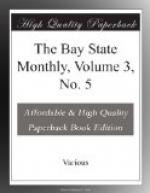* * * * *
A MODEL INDUSTRIAL CITY.
By Fanny M. Johnson.
[Illustration: CONN. RIVER RAILROAD STATION.]
On a sweeping curve of the Connecticut river, about twelve miles north of the Massachusetts and Connecticut boundary line, is the modern manufacturing city of Holyoke, with a present population of 30,000. It is the most extensive paper making city in the world, and the manufacture of paper is but one of many enterprises. The ceaseless water-power of the great river turns the wheels of numerous industries which, within the third of a century, have been located here and have transformed a sparsely settled rural parish into a busy and populous city.
Holyoke is a New England growth. It does not resemble the smoky cities of the iron regions, nor the languid towns of the South. The swift, powerful current of water does its work without confusion, smoke or waste. Pure breezes sweep along the valley through the mountain rifts, and the mountains serve as barriers to ward off heavy gales and destructive tempests. The slope of the land toward the river gives opportunity for healthful drainage and the vicinity of mountain springs and reservoirs supplies a great requisite for a thickly settled city.
[Illustration: THE EPISCOPAL CHURCH.]
The impression which Holyoke makes upon its visitors is of modern thrift and growth. Travellers by railway who enter the city from the north, look with interest at the great dam, crossing the river from the Holyoke to the South Hadley Falls shore. Rounding the curve, the large brick buildings, spires and chimneys of the city come suddenly into view, the tall tower of the granite city hall rising high above the rest. The buildings are modern in structure and architecture. Little is found here that bears the moss and rime of age.
Less than forty years ago, when the railroad was still a novelty in the Connecticut Valley, a party of capitalists came to view the water-power along the rocky bed of the Connecticut River at the point called the Great Rapids, or Falls of South Hadley, which extended over a mile and a half and had a total fall of 60 feet. The volume of water was gauged and found to aggregate a power equal to 30,000 horse-power. This was in 1847. The next Legislature was petitioned by Thomas H. Perkins, Geo. W. Lyman, Edmund Dwight and others for an act of incorporation as the Hadley Falls Company, “for the purpose of constructing and maintaining a dam across the Connecticut River, and one or more locks and canals in connection with said dam; and of creating a water power to be used by the said corporation for manufacturing articles from cotton, wood, iron, wool and other materials, and to be sold to other persons and corporations, to be used for manufacturing or mechanical purposes and also for the purposes of navigation.” The capital stock was fixed at $4,000.000. The Hadley Falls Company purchased the property and franchise of the South Hadley Falls Locks and Canal Company, and extinguished the fishing rights existing above the location of the dam.




